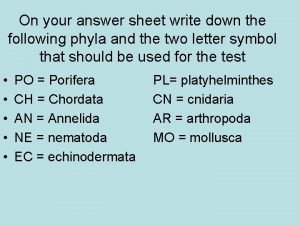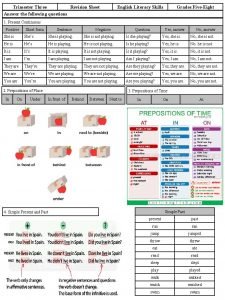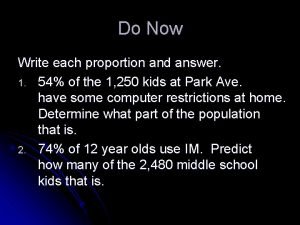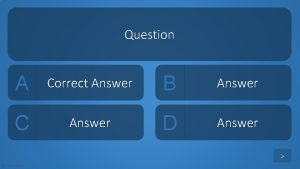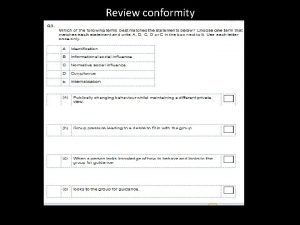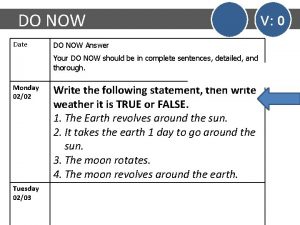Do Now On your Do Now paper answer










- Slides: 10

Do Now • On your Do Now paper, answer the following based on this data set: 0, 5, 12, 18, 22, 25, 26, 28, 28, 29, 31, 50. • What is the. . . 1. Mean? 2. Median? 3. Mode? 4. Range? 5. IQR? 6. Variance? 7. Standard Deviation? 8. Shape? The Practice of Statistics, 5 th Edition 1

CHAPTER 2 Modeling Distributions of Data 2. 1 Describing Location in a Distribution The Practice of Statistics, 5 th Edition Starnes, Tabor, Yates, Moore Bedford Freeman Worth Publishers

Describing Location in a Distribution Learning Objectives After this section, you should be able to: ü FIND and INTERPRET the percentile of an individual value within a distribution of data. ü ESTIMATE percentiles and individual values using a cumulative relative frequency graph. ü FIND and INTERPRET the standardized score (z-score) of an individual value within a distribution of data. ü DESCRIBE the effect of adding, subtracting, multiplying by, or dividing by a constant on the shape, center, and spread of a distribution of data. The Practice of Statistics, 5 th Edition 3

Transforming Data Transforming converts the original observations from the original units of measurements to another scale. Transformations can affect the shape, center, and spread of a distribution. Effect of Adding (or Subtracting) a Constant Adding the same number a to (subtracting a from) each observation: • adds a to (subtracts a from) measures of center and location (mean, median, quartiles, percentiles), but • Does not change the shape of the distribution or measures of spread (range, IQR, standard deviation). The Practice of Statistics, 5 th Edition 4

Transforming Data Example Examine the distribution of students’ guessing errors by defining a new variable as follows: error = guess − 13 That is, we’ll subtract 13 from each observation in the data set. Try to predict what the shape, center, and spread of this new distribution will be. n Mean sx Min Q 1 M Q 3 Max IQR Range Guess(m) 44 16. 02 7. 14 8 11 15 17 40 6 32 Error (m) 44 3. 02 7. 14 -5 -2 2 4 27 6 32 The Practice of Statistics, 5 th Edition 5

Transforming Data Transforming converts the original observations from the original units of measurements to another scale. Transformations can affect the shape, center, and spread of a distribution. Effect of Multiplying (or Dividing) by a Constant Multiplying (or dividing) each observation by the same number b: • multiplies (divides) measures of center and location (mean, median, quartiles, percentiles) by b • multiplies (divides) measures of spread (range, IQR, standard deviation) by |b|, but • does not change the shape of the distribution The Practice of Statistics, 5 th Edition 6

Transforming Data Example Because our group of Australian students is having some difficulty with the metric system, it may not be helpful to tell them that their guesses tended to be about 2 to 3 meters too high. Let’s convert the error data to feet before we report back to them. There are roughly 3. 28 feet in a meter. n Mean sx Min Q 1 M Q 3 Max IQR Range Error (m) 44 3. 02 7. 14 -5 -2 2 4 27 6 32 Error(ft) 44 9. 91 23. 43 -16. 4 -6. 56 13. 12 88. 56 19. 68 104. 96 The Practice of Statistics, 5 th Edition 7

Transforming data • The Practice of Statistics, 5 th Edition 8

Describing Location in a Distribution Section Summary In this section, we learned how to… ü FIND and INTERPRET the percentile of an individual value within a distribution of data. ü ESTIMATE percentiles and individual values using a cumulative relative frequency graph. ü FIND and INTERPRET the standardized score (z-score) of an individual value within a distribution of data. ü DESCRIBE the effect of adding, subtracting, multiplying by, or dividing by a constant on the shape, center, and spread of a distribution of data. The Practice of Statistics, 5 th Edition 9

Homework • Finish HW 2. 1 and turn in tomorrow The Practice of Statistics, 5 th Edition 10
 Answer this question in your notebook
Answer this question in your notebook In your notebook answer the following
In your notebook answer the following Do the following in your notebook.
Do the following in your notebook. Now answer the following questions in your notebook
Now answer the following questions in your notebook In your answer sheet, answer the following questions
In your answer sheet, answer the following questions Trimester fill in worksheet answers
Trimester fill in worksheet answers Solve each proportion write your answer in your notebook
Solve each proportion write your answer in your notebook Give us your hungry your tired your poor
Give us your hungry your tired your poor Now i see it now you don't
Now i see it now you don't Paper due now
Paper due now English general paper paper 2 comprehension
English general paper paper 2 comprehension




